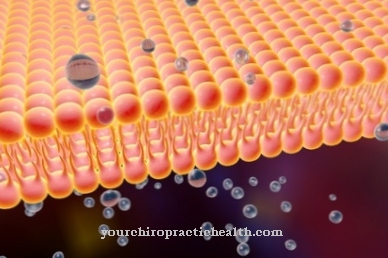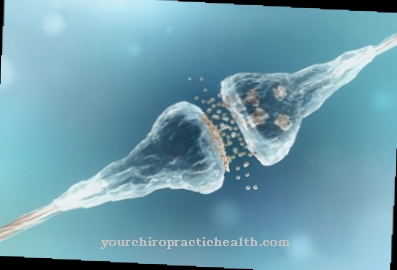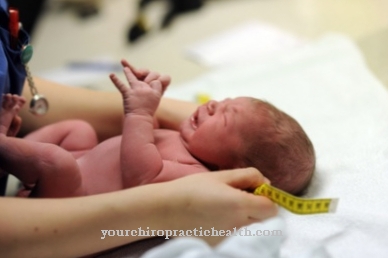The oxygenation refers to the binding of the red blood pigment to oxygen molecules. The opposite is also called deoxygenation and takes place when the CO concentrations are too high or the pH value in the blood is too low. The progressive deoxygenation endangers the oxygen supply of the organs in the case of carbon monoxide intoxication.
What is oxygenation?

The red blood pigment hemoglobin gives the red blood cells their color and also fulfills important functions in the respiratory chain. The hemoglobin contains a bivalent iron compound that can bind to oxygen. It is therefore also referred to as being oxygen-affine. The oxygen binding of the red blood pigment is called oxygenation in medical terminology.
The blood thus fulfills the task of a transport medium during respiration and brings the oxygen to individual organs and tissues. Oxygen is present in the blood in both bound and physically dissolved form. The dissolved form plays a role in particular for the exchange of oxygen between the lung alveoli and the plasma. The oxygen exchange between the blood plasma and the interstitium is also dependent on dissolved oxygen, since this process is carried out via diffusion.
However, oxygen has only limited solubility. The hemoglobin-bound oxygen transport maintains the vital cell supply with oxygen despite the limited solubility.
Function & task
During oxygenation, oxygen binds to hemoglobin. As a result, the molecule changes its conformation, i.e. the spatial arrangement. During this process, the central iron atom of the blood pigment changes its position.In this way the binding achieves a dynamic functional state. In the case of oxygenation, there is no real oxidation or chemically complex reaction.
Unbound hemoglobin is also known as deoxyhemoglobin and appears as a tense T-shape. Only when it binds to oxygen atoms is the blood pigment converted into the relaxed R-form, which is also known as oxyhemoglobin. The affinity of hemoglobin for oxygen depends, for example, on factors such as the conformation of the molecules. In the relaxed R-form, the red blood pigment has more affinity than in the tense T-form.
The pH value also plays a role in the oxygen binding affinity of hemoglobin that should not be underestimated. The binding affinity of hemoglobin also increases with increasing pH. The temperature has an equally great influence on the binding affinity of the red blood pigment. The affinity increases with decreasing temperatures and, as a consequence, is lost when the core temperatures are too high. In addition to these factors, the binding affinity of hemoglobin is also dependent on the carbon dioxide concentration.
The dependence on the factors carbon dioxide content and ph value of the blood is summarized as the so-called Bohr effect. At high pH and low carbon dioxide levels there is a high affinity. The concentration of oxyhemoglobin increases accordingly under these conditions. As a consequence, the binding affinity decreases with a high carbon dioxide content and a low pH value.
The body's bloodstream naturally takes these factors into account when transporting oxygen. For example, the capillaries of the lungs have a low carbon dioxide content and a relatively high pH. The binding affinity of hemoglobin in the lungs is accordingly high. This leads to the oxygenation of the red blood pigment. Outside the pulmonary capillaries, there is a relatively high CO2 content with a low pH value. The binding affinity of the hemoglobin decreases accordingly and releases the oxygen bit by bit, which is then taken up by the tissues and organs.
This dissociation of the oxygen from the hemoglobin molecules is known as deoxygenation and is just as important for the supply of oxygen to the body as oxygenation.
Illnesses & ailments
In the case of carbon monoxide intoxication, the oxidation of the hemoglobin is limited or even completely disabled. This is because the binding affinity of hemoglobin for carbon monoxide is about 300 times as high as the binding affinity for oxygen. In this way, in the event of smoke inhalation, carbon monoxide accumulates in the hemoglobin in a very short time, thus creating carboxyhemoglobin. This creates a blockage for the uptake of oxygen and the oxygen content in the blood drops bit by bit.
Strong CO poisoning therefore triggers hypoxia, i.e. a general undersupply of body tissue and organs with oxygen. When the CO level in the blood reaches a certain percentage, the person concerned passes out due to this undersupply. If the level continues to rise after a faint, death occurs above a certain concentration. If the oxygen supply is insufficient, body tissue dies irreversibly.
Oxygen therapies are available to treat decreased oxygen concentrations in arterial blood. These therapies are also helpful for pulmonary embolism. The same applies to heart attacks, respiratory insufficiency or heart failure. Many cardiopulmonary diseases are threatened with hypoxia.
Hypoxia is also threatened with anemia, as there are too few red blood cells in the plasma in this disease. The less hemoglobin, the less oxygen can be transported into the organs in the bound form. Anemia can result from blood loss, but it can also be caused by a lack of iron or folic acid.
Blood formation disorders can also lead to anemic phenomena, which may be associated with further blood formation disorders and other accompanying symptoms. Anemias are treated depending on their cause and regress in the context of deficiency symptoms as soon as the causal deficiency has been remedied.













.jpg)

.jpg)
.jpg)











.jpg)